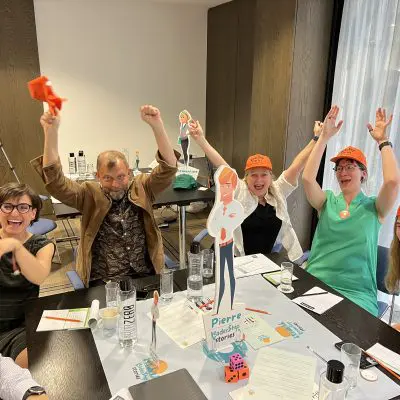We all learn something new every day. Whether it’s a small tidbit like how to use a feature on the copier or a big insight about ourselves, engaging in continuous learning is an important part of growing as a person and a professional.
In our podcast episode, Inside the Mind of the Mentalist, we spoke with America’s Master Mentalist, Jon Stetson. We discussed psychology, how to be your best self, and—most importantly—the importance of continual learning.
What is Continuous Learning?
First things first—what is continuous learning? As the name would suggest, continual learning is the process of constantly working to expand your knowledge and skill sets. Continuous learners are always learning new things to apply to their lives and work.
It’s easy to get complacent, especially in the context of work. You have a job and the skills necessary to fulfill that role, so why expend the effort to learn more knowledge you don’t really need?
As Stetson pointed out in our discussion, complacency can lead to your skills withering away. It’s important to keep learning so you can keep your edge and stay motivated. He said:
“When you’re green you grow, and when you’re ripe you rot. I subscribe to that every day. I want to learn something new.”
Ultimately, it’s a simple concept. Continual learners are always gaining new knowledge, expanding their current skills, and working hard to stay engaged and motivated.
Benefits of Continuous Learning at Work
There are many benefits of continuously learning at work. Much like professional development, learning at work can help better your employees and business as a whole. Not to mention employees pick all sorts of useful knowledge and skills in the process.
To really underline the importance of constant learning at work, let’s take the time to look at some of the biggest benefits of learning at work.
Invests in Employees’ Futures
The first benefit of continuous learning is that you get to invest in your employees’ future. That may sound simple, but there are numerous benefits that come with investing in your employees and their futures. Employees are your greatest asset. Treating them well and fostering their future careers improves your reputation. In turn, that can make finding highly qualified candidates easier and retaining those candidates easy as well.
Besides that, employees are what drive a business towards success. More knowledgeable and skilled employees translates to increased productivity, efficiency, creativity, and innovation—all of which can help you get a leg up on competition.
You also get the benefit of creating a pipeline of highly skilled and motivated employees who will continue to grow. An investment in an employee today will pay dividends weeks, months, or years later.
Increases Employee Confidence & Productivity
Another benefit is that constant learning increases employees’ confidence and productivity. Employees work their best when they feel cared about and valued, and prioritizing their growth is an effective way to do that.
This resulting increase in confidence has its own benefits. For example, confident and engaged employees are less likely to engage in coffee badging or resenteeism. So not only can it increase productivity, it can help prevent negative behaviors.
Confident and productive employees are also better for a business as a whole. They are more likely to present new ideas, give projects their all, and work as hard as they can to help a company achieve its goal. Overall, a workplace that focuses on learning will have a stronger, more knowledgeable and motivated workforce that is more productive, creative, and pushes a business forward to success.
Boosts Retention
One of the more notable benefits of continuous learning is boosted retention. Retention can be a difficult thing for many businesses, especially in modern times as more and more employees are willing to job-hop for better pay, benefits, and company culture.
But since continual learning directly shows employees that you value their efforts and are willing to invest in their futures, it can have a big impact on retention. With lower attrition rates, you can keep top talent as they get promoted through the ranks. Because of that, it can also be easier to find new top talent. As word spreads about your company and its culture, you’ll attract more and more highly skilled candidates. This makes it easier to fill roles and form talented teams.
Helps You Adapt to Sudden Changes
Lastly, continual learning can help you, your employees, and business adapt to sudden changes. Changes are inevitable, and many of us are naturally reluctant to change. However, embracing change is essential, as Stetson pointed out when he said:
“But if it comes to something brand new, full-blown stuff, yeah, let’s take that challenge on. So many of us want to just resist things. I was one of those people. I did not like the word change.”
Being a constant learner helps employees get used to change. It also helps them gain new skills that can help them deal with change when it arises, which helps future-proof your business by making it easier to weather those changes.
All of this goes to show you shouldn’t underestimate the importance of continuous learning in the workplace. With all the various benefits, it’s clear that a culture of continual learning should be standard in every business.
How to Foster Continuous Learning in the Workplace
It’s easy to understand why continual learning is important in the workplace, but fostering it is often more difficult than it seems. However, there are many different strategies and techniques you can use to create a culture of learning.
To wrap things up, we’re going to provide a few tips to help you foster learning in the workplace. Remember that every employee is different and has their own style of learning. You may need to tailor programs or strategies to your employees to have maximum impact.
Don’t Punish Failure
Possibly the most important tip to promoting continuous learning is not to punish failure. Failure is a necessary part of learning and growth. Punishing employees for failure discourages them from learning and growing further, as they might be punished for making mistakes.
If you want to help an employee become a continuous learner, you should value failures. They are an opportunity to learn more, and they should be used to reflect and continue learning and growing. Our lives are journeys of continual learning powered by what we learn from our mistakes and failures. Often, it takes us decades to really understand how to learn from them. This is a point Stetson made when he said:
“I personally don’t think we become good students until we’re 40 years old, in life and in general. There is no substitute for life experiences.”
Point being, failure is necessary for growth. Let employees fail, and help them learn from those mistakes instead of punishing them.
Take Time for Learning
If you want employees to keep learning, you need to set aside time for it. While that may seem incredibly obvious, many overlook it and seem to forget that learning is a conscious effort that takes time. You can tell employees they need to learn in their off hours, but people have lives. They have families, hobbies, and interests they aren’t going to sacrifice just to learn a new sales tactic or marketing strategy.
Give employees opportunities to learn during the workday. They will be much more receptive and likely to engage in learning opportunities if it’s during their typical working hours. E-learning and in-person classes can both be easily offered at work.
Reward Innovation
Another good strategy is to reward innovation. This encourages employees to learn new things and strive to innovate. As simple as it is, a good reward is almost always an effective motivator in the workplace.
Employee incentive programs can be incredibly effective here. For example, a program that rewards employees for taking classes outside of work can have a huge impact on how many employees engage in continual learning.
Outside of that, it also shows employees that you value them and are willing to reward the efforts. This has numerous benefits in and of itself, like increased retention and engagement.
Foster Shared Learning Experiences
One last strategy to consider is fostering shared learning experiences. These can be incredibly impactful and are one of the best examples of continuous learning in the workplace. Here are some examples of potential shared learning programs:
Team Leadership DNA
This event helps employees identify their own strengths and weaknesses, as well as those of their team members. This helps boost teamwork, leadership, communication, and more through shared learning.
Team Resilience Training
By learning about techniques together to improve resiliency—such as maintaining wellness and proper sleep hygiene—teams can become more resilient and start prioritizing their continual learning.
Effective Communication
Communication is key in any business, especially in ones that prioritizing learning. This event helps teams get tools and insights to communicate more directly and effectively.
Promote Continuous Learning with TeamBonding
Continuous learning is the process of constantly improving your skills and gaining new knowledge. Creating a pro-learning environment can help increase productivity, retention, your reputation, employee wellbeing, and much more.
One of the best ways to promote learning in the workplace is with team building events, and at TeamBonding, we have a whole suite of events that are perfect for placing an emphasis on learning. Partner with TeamBonding today to start promoting continual learning in your workplace. We’re ready to help, so get in touch with us today.
















